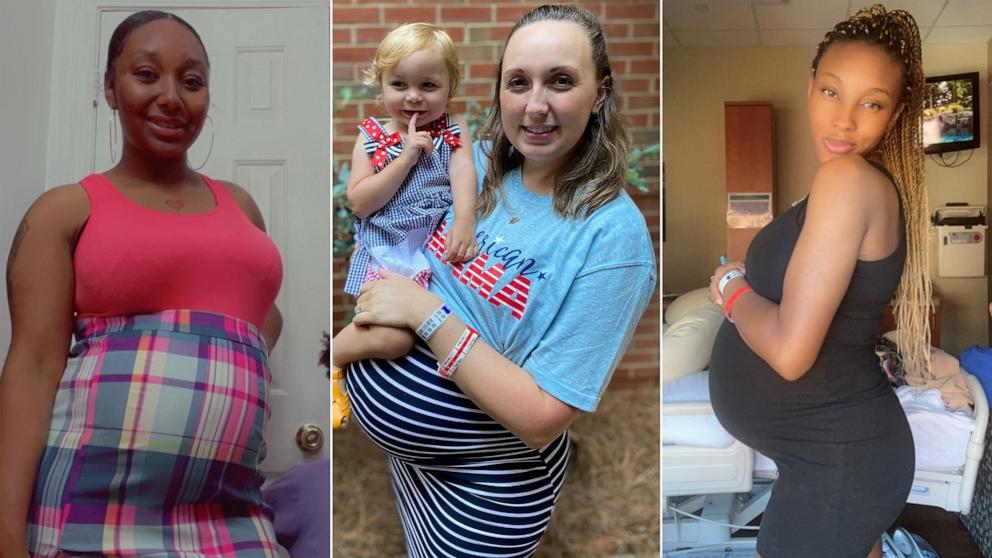


Summer Morrison, a mom of three from North Carolina, was several weeks into her eight-week stay in a high-risk maternity unit for a rare condition known as monoamniotic twins when she learned another mom with the same condition had just been admitted.
"I remember sending my nurse a note like, 'Can you pass this note to her?'" Morrison told "Good Morning America." "I gave her number to text me and tried to give her some encouragement and tips and things that I had been doing, because I'd already been there for a while."
She added, "It was nice just to know that another mom doing the exact same thing I'm doing had just showed up."
On the receiving end of Morrison's note was Keaira Davis, who said she had never heard of a monoamniotic pregnancy when she was diagnosed with it in her first trimester. A monoamniotic pregnancy occurs when identical twins from a single fertilized egg share one placenta and one amniotic sac.
Davis said she didn't even know where to start when it came to questions for Morrison.
"Once I read her note, and I started thinking, I'm like, I don't even know where to start. I don't even know what to ask her," Davis told "GMA." "I didn't want her to feel overwhelmed with all my questions, because I [was] overwhelmed as well."
Monoamniotic twins occur in less than 0.1% of all pregnancies, according to the Columbia University Department of Obstetrics and Gynecology.
The condition requires near-constant monitoring because complications can occur, including the umbilical cords becoming entangled, which could be fatal for the twins. Because of the need for close monitoring, moms carrying monoamniotic twins are typically admitted to the hospital near the end of their second trimester.
Davis said she found a huge sense of comfort in meeting Morrison in the high-risk maternity unit and knowing that she was going through the same thing.
MORE: Twin sisters born on different days in different yearsA few weeks into her stay, Davis said she received a knock on the door from another mom, Vakoya Miller, who had just been admitted to the unit with the same condition.
Miller said she learned from a nurse that Davis was also expecting monoamniotic twins, also known as MoMo twins, and reached out to her with "a million questions."
"I kept asking the nurses, like, 'Do you think she'll mind if I go over there and talk to her?" Miller said. "I was literally so nervous, but then I went in there and we just started talking. I was like, 'I have a million questions for you.'"
Miller was a first-time mom who was going through a high-risk pregnancy. Both Davis and Morrison had older daughters they balanced caring for while spending over one month hospitalized.
MORE: Couple welcomes 2 sets of 'rare' twins 14 months apartMonoamniotic twins are so rare that they happen in around 1 in every 8,000 pregnancies, according to Dr. Michael Jones, an OB-GYN at Atrium Health Women's Care, who treated all three women.
Jones told "GMA" that in his 37-year career as a board-certified OB-GYN and as a resident, he had never treated a monoamniotic pregnancy. Then, within a matter of months, he was treating three patients with the condition: Morrison, Davis and Miller.
Jones was also present for all three of the cesarean section deliveries, which resulted in three sets of healthy twin girls.
"They were all delivered within about six weeks of each other," Jones said, adding that the babies' umbilical cords were all wound like "hair braids" upon delivery. "They move so much that there were like 20 or 30 twists."
Morrison delivered her twin daughters, named Ada and Ivy, on July 20, 2022. The twins, who each weighed around 4 pounds at birth, spent over two weeks in the neonatal intensive care unit.
Davis gave birth to her twins Remi and Rayne on Aug. 19, 2022, and saw them through six weeks in the NICU.
Miller delivered her twin daughters around one month later, on Sept. 28, 2022. The twins, Raleigh and Saylor, were born weighing around 4 pounds each and spent 29 days in the NICU.
In the months since they've been home from the hospital, the three moms have stayed in touch, bonding over the rare pregnancy condition they endured together and helping each other raise their twins.
Earlier this fall, the six girls and their moms reunited with Jones, who described the reunion as one of the most meaningful moments of his nearly three-decade career.
"They spent a lot of time together and they spent a lot of time with us," Jones said. "The picture of all them in my lap, I think that's my favorite picture of all time. It makes me cry almost every time. It's absolutely special."